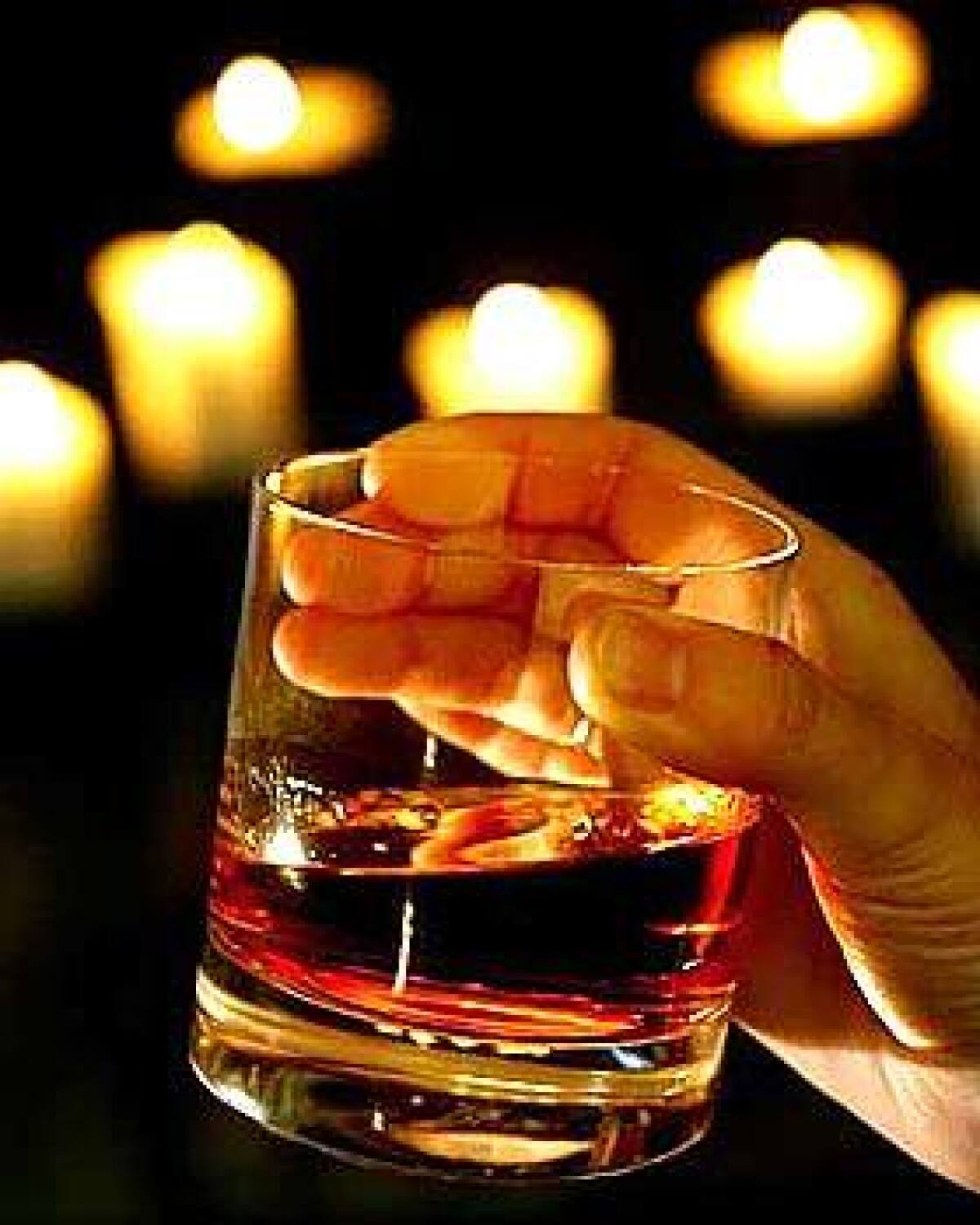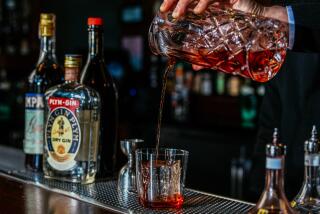One barrel, one bourbon

- Share via
For the longest time, Bourbon and I had a May-December relationship: We got together for the Kentucky Derby in springtime and for eggnog at the holidays. Since the allure in either season was only high proof and aggressive flavor, any Bourbon would do. What was good enough for old grand-dad was good enough for me.
But in the last few years, the original American whiskey has literally come of age. The potent old mainstays with backwoodsy names along the lines of Wild Turkey and Rebel Yell can still be found, but these days they are being increasingly crowded by new variations designed to elevate Bourbon to connoisseur status, with lineage-evoking labels like Elijah Craig and Kentucky Spirit.
In this age of microdistilling, these are what are known as single-barrel Bourbons. They’re serious whiskeys that are even more handcrafted than those in the last big trend, small-batch Bourbons. Many even boast a vintage on the label.
These “newer” — but actually older — Bourbons are far too good to cut with eggnog. They demand the same attention as a fine Cognac, and they’ll command the same respect. The best of them has a mouth-filling headiness, a smooth and sweet caramel base overlaid with almost pepperiness, not to mention a decided oakiness from the barrels they age in. Like all great spirits, they engage all senses, particularly smell and sight.
They’re meant for sipping at the end of a festive meal. But as barroom connoisseurship devolves into one-upmanship, they are beginning to turn up in cocktails as well. If high-end vodkas can get lost in the Cosmos, why not show off $40-a-bottle single-barrel Bourbon in a Manhattan?
Most important right now, with the calendar counting down, single-barrel Bourbons make a jazzy gift, too. If the flavor weren’t so sensational, the bottles alone would make them stand out. Not one has a screw top, for starters. Most are as heavy as crystal and flaunt their Bluegrass origins (a little metal horse and jockey on a stopper, for instance).
Just how radically Bourbon has evolved came clear to me when I opened an old Kentucky favorite, along with the new Elijah Craig single-barrel Bourbon. Both Heaven Hill and the 18-year-old Elijah Craig are produced by the same company based in Bardstown (Stephen Foster’s old “home”) whose distillery I toured way back in 1977. But they could not be more different.
Heaven Hill is, to put it bluntly, one step above paint thinner: watery but pungent, with more fire in your throat than caramel on your tongue. Elijah Craig — named for the preacher who produced the very first Bourbon, in 1789 — is buttery but edgy, with burnt-sugar undertones and an aroma that is anything but nose-singeing. I would serve it in place of Cognac any time. Elijah Craig is the best of the single-barrel Bourbons I’ve tasted. Not surprisingly, the distiller contends it’s also the most aged of any on the market, at 18 years in charred oak (or, as the marketers put it, “72 seasons”).
For anyone whose gold standard of Bourbon is top-selling Maker’s Mark, single-barrel Bourbons may be a bit of an acquired taste. They’re much more powerful on the palate. Maker’s, produced the same way since 1953, remains the quintessential smooth Bourbon, neither overly sweet nor extremely challenging. There’s nothing more accommodating for mixing with anything from festive mint syrup to plain old Coke. Like the best of the mainstream Bourbons, Maker’s Mark is blended from an array of barrels of whiskey; point of origin is less important than final flavor.
Pure appeal
The small-batch Bourbons that stole Maker’s thunder in the 1990s are more refined, made from the contents of a few sedulously selected barrels, blended for smoothest flavor. These are brands like Knob Creek and Baker’s and Basil Hayden, all boutique bottlings from Jim Beam. By contrast, single-barrel Bourbons are just what they sound like: Only the liquor aged in one charred white oak barrel is in the bottle. All of it is the same age, the same taste, with the same nuances from the same wood. The flavor, to my palate, is much more upfront than from even a seriously good blend.What sets all Bourbon apart from other alcohol is signaled by its original name: corn whiskey. Under a federal law passed in 1964, 51% of the mash it’s fermented from must be corn. The rest is wheat, barley or rye. (Contrary to myth, the law does not stipulate that Bourbon can only be Bourbon if it is produced in Kentucky — Virginia and Tennessee also make it.)
As anyone who understands what makes soft drinks so sweet should know, corn is one seriously sugary beginning for a spirit. And an overtly sweet sensation may be what characterizes Bourbon above everything else. Unlike Cognac, which the best Bourbons emulate, the flavor is more akin to dulce de leche. You can almost smell sugar.
Distillers in the whiskey’s namesake Bourbon County have always sworn that the local water, filtered through limestone and high in minerals, adds another undercurrent of flavor. That may be hard to prove, but it’s undeniable that the charred oak barrels the industry has used since the 1860s give color as well as intensity to the taste (although added caramel undoubtedly contributes more). By law, Bourbon must be aged at least four years. But more and more producers are doubling and tripling that.
Most single-barrel Bourbons run about $32 to $45 for a 750-milliliter bottle, compared with $12 or $13 for a brand like Heaven Hill and about $20 for a small-batch brand like Knob Creek. (Some small-batch Bourbons can cost more than $100, though.)
In these unsettled and unsettling times, Bourbon marketers are making much of the fact that theirs is the one spirit that qualifies as “freedom booze,” invented and made in America. The whole world of Bourbon may be emblematic of America in another way: Sales are most robust at the high end of the market, in the super-premium segment (as grandiose as that adjective sounds, it really connotes only a price tag of more than $20).
Using them in a cocktail might seem extravagant, but if money’s no object, it’s hard to deny a single-barrel Bourbon will transform any drink, even eggnog. With classic cocktails like the Manhattan and the old-fashioned making a comeback, better Bourbons should as well. As with any spirit, the better the base, the finer the finish.
If I have any Elijah Craig or Blanton’s left next spring, though, I’ll have it locked away and just let the Maker’s Mark fight it out with the mint in the juleps.
*
Smooth sippers
Here are four single-barrel Bourbons that are superb when sipped straight but will also dramatically upgrade any cocktail. All come in bottles impressive enough for giving too. They’re all available at Wine and Liquor Depot in Van Nuys, (818) 996-1414; selected brands can also be found at wine shops such as Wine Exchange in Orange, (714) 974-1454, and Wine House in West L.A., (310) 479-3731.
Elijah Craig 18-Year-Old: Extremely smooth, with undertones of burnt sugar; mellow but intense aroma. About $32.
Blanton’s: Slightly more mellow than Elijah Craig, with caramel flavor and an almost perfumey aroma. About $42.
Kentucky Spirit (made by Wild Turkey): Not overly sweet; flavor is needly on the tongue but smooths out as you swallow. About $37.
Michter’s: Less caramelly, with sharp and almost smoky flavor from beginning to end. About $44.
— Regina Schrambling
More to Read
Eat your way across L.A.
Get our weekly Tasting Notes newsletter for reviews, news and more.
You may occasionally receive promotional content from the Los Angeles Times.








